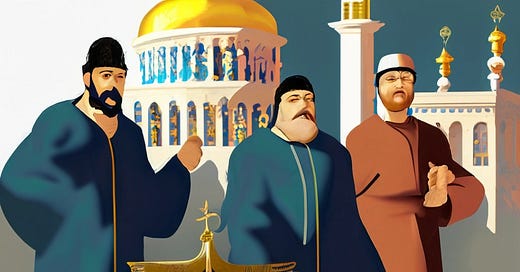The global issue with Russia's national cultural identity
The Russian government institutes national religious identities, creating hidden and secret subcultures that enable jihadist networks.
It is evident from the Crocus City Hall attack and the Makhachkala mob, there remains a lingering broken cultural and social element within the Russian-speaking Muslim community. The core networks that generate jihadist factions throughout Eurasia and across Europe originate heavily from the Muslim communities of the former Soviet Union. According to the Kremlin, Russia has addressed sufficiently the issues of terrorism, and Wahhabism through national cultural identity.
During the Soviet era, communism was the religion. Communist Russia’s character altered under different reigns such as the Bolsheviks, Stalin, Khrushchev, and Gorbachev. Nevertheless, the Soviet governments enforced the cultural tenants of national identity on the population.
In the early 2000s, President Putin and his advisors recognized the state needed a new national cultural identity. The Russian Federation's consolidation of regional power and domestic turbulence necessitated something to replace communist identity. Dictated by the state, Russia prescribes three main religions to represent its ethnicially diverse peoples: Orthodox Christianity, Orthodox Judaism, and Sunni Islam.
Whenever an incident occurs, these ethnically appropriate figureheads step out in traditional dress to reenforce managed identity. The Chief Rabbi of Russia is the Orthodox, Hassidic Berel Lazar. Representing Orthodox Christianity is Vladimir Mikhailovich Gundyayev the Patriarch Kirill of Moscow. Islamic affairs are led by Supreme Mufti Talgat Safich Tadzetdinov, an ethnic Sunni with Tatar decent. Every single one toes the Kremlin’s line or faces unemployment like Pinchas Goldschmidt.
After an act of violence, the Kremlin roles out these religious figures on national television to affirm the government’s position. Sometimes, there are commentaries to contextualize religious issues related to acts of terrorism for the Russian audience. However, the core issues related to the violence are rarely addressed such as education, economic opportunity, safety, security, social balance, mental health, freedom of speech, or religious freedom.
There is an anecdotal story, which the Russian news reported on a few months ago, that encapsulates Russia's approach to national cultural identity. In the past year two Russian officials apologized publicly to Chechen President Ramzan Kadyrov. Mikhail Matveyev showed deference to Mr. Kadyrov by filming himself apologizing for "radical Islamist" comments referring to immigrants in Russia. In a separate context, Konstantin Chuychenko apologized for referring to Mr. Kadyrov as "a shame to Russia". It may seem appropriate to apologize for racist remarks but this is hardly exceptional to religion or race.
There are several videos of others, like soldiers in Ukraine, and Chechen youth apologizing to Mr. Kadyrov for various behaviors. The offenses range from rudeness in public transportation to blogging political and cultural dissent. Even comments that occur outside of Russia’s borders in Europe. In all incidences, these citizens and officials received instructions to publicly record themselves apologizing to Mr. Kadyrov.
For the sake of context, President Kadyrov and President Putin have a kinship that comes across in interpersonal interactions. President Putin can barely keep a straight face when he speaks with President Kadyrov. This may also be due to Ramzan Kadyrov’s personality mixture of unintelligible Russian and gregariousness. Even referring to him as a son. There are rumors circulating that Mr. Kadyrov may serve as a deputy in Russia’s Ministry of Internal Affairs. The pressure to apologize to President Kadyrov likely comes from the top.
In Russia, this is national cultural identity in practice. Under the control of the Russian government, the Republic of Chechnya defines its Muslim-self as a mix of Sunni Islam and certain ancient shaman traditions. On the approved list are Chechen lezginka, traditional dress, and certain music stylings. Western culture is also on the chopping block as evidenced by the Chechen government banning music outside of 80 to 116 beats per minute to reduce Western cultural influences.
The government also manages how men and women dress to express their Islamic faith. It is not exactly a state issued uniform perse but some certainly feel this way. Certain styles related to Salafism, which is gaining popularity among Muslims of this region, are not permitted.
Supposedly, these extreme measures were in response to the rampant separatist and terrorist problems that plagued Chechnya. To stabilize the state, the government targeted anything resembling Wahhabism and Salafism through “eradication and elimination policies”. It is not just the individual who is killed or jailed, the entire clan goes under investigation. From Vienna to Strasbourg, Europe is littered with Chechen nationals murdered in broad day light.
As a result, grassroots cultural movements, to include pro-gay movements, must remain hidden to survive. People learn secretive means to express themselves. It also creates a social atmosphere prone to and accepting of secretive lifestyles. Unfortunately, radical groups leverage this type of socially deceptive maneuvering to cover their nefarious tracks.
Tens of thousands of Russian-speaking jihadists died in Syria and Iraq over the last ten years. However, it only means Eurasia and Europe will have some generational peace. The pernicious cycle continues as the younger children grow old enough to understand the disenfranchisement. Even more emotionally compelling is learning of their respective families’ mistreatments in the past by the government.
Between the societal problems and tendency for hidden subcultures, Russia continues to be a cultural breeding ground for jihadist cultures. Even indirectly, these communities facilitate terrorist groups in Eurasia. The complex cultural reactions to the Russian government’s control indicates that the environmental conditioning is still prime for radicalism. Whether it manifests under the ISIS flag or whatever that devolves into next, we will see more of it yet to come.
~E
Gray Truths©️2024



